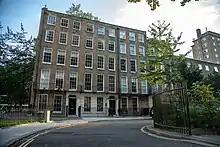Blackfriars Settlement
Blackfriars Settlement charitable organization in the UK established to improve the well-being of disadvantaged people.[1] It was originally established as the Women's University Settlement in 1887,[2] and focused especially on the needs of women and children.[3] It was part of the settlement movement promoted by Rev Samuel Barnett who prompted young people with university educations to settle in the worst areas of poverty.[4] The Women's Library has an archival collection of documents related to the group.[5]

History
The Women's University Settlement was founded after a talk by Henrietta Barnett to the Cambridge Ladies' Discussion Society. Toynbee Hall had been founded in 1884, and female students resolved to set up a similar project. Representatives from Girton College and Newnham College at Cambridge University, and Lady Margaret Hall and Somerville College at Oxford University, formed the Women's University Association. A Newnham student Alice Gruner was appointed Head Worker, and the organization was based at her house at 44 Nelson Square, Southwark. Other Newnham students involved in the venture included Mary Paley Marshall,[6] Nora Sidgwick, and the Prime Minister's daughter Helen Gladstone.[7] Octavia Hill, who became a housing reformer and founder of the National Trust, was also an active member.[2] In 1888 the Association was renamed the Women's University Settlement. Gruber resigned as Warden, and in 1891 a paid Warden, Margaret Sewell, was appointed. By 1895 the Settlement had 31 resident and 61 non-resident workers. It organized children's clubs, holiday treats and classes in music and dance for local children.[6] Helen Gladstone served as Warden in the early twentieth century.[7]
By 1912 the Settlement had started to train social workers for work elsewhere. However, its lack of institutional funding forced a public appeal for funds, to buy a hall and ensure a secure financial footing.[8] In 1926 the Settlement's activities included a baby centre, a mixed children's club for boys and girls, the Southwark Boys' Aid Association, work on care committees and remedial exercises and light treatment for children. Graham Wallas, presiding at the organization's AGM, saw it as exemplifying the way in which social work had moved from Victorian amateurism to professional activity on scientific lines.[9] Wyndham Deedes reported ongoing growth at the 1929 AGM: a nursing school, a clothes sale section and a legal aid department had been established, and the number of children under the Settlement's infant welfare section had risen to 1,200.[10]
In 1961 the group's name was changed to Blackfriars Settlement in respect to men's involvement and to be more inclusive of local community involvement.
The organization moved into the Rushworth Street building in 1992, a purpose-built structure that replaced a run-down Georgian Town House. It in turn became dated with leaks in its flat roof and Blackfriars rented accommodations on at Suffolk Street while renovations took place.[2]
Baroness Margaret Wheeler who heads UNISON and serves in the House of Lords is the group's trustee and chair.[11]
In 2010, the organization moved its headquarters to Great Suffolk Street.[12] Workers on the nearby Blackfriars Station made a donation to the charity.[13]
Rev. Mark Beach became the group's director in 2015 succeeding Julie Corbett-Bird.[14]
In 2019, the organization received funding for pop-up friendliness cafés.[15]
References
- Gladys Barrett, Blackfriars Settlement: A Short History, London, 1985.
- "Our History". www.blackfriars-settlement.org.uk.
- Powell, E. G. (April 1914). "The Women's University Settlement in Southwark". Charity Organisation Review. New Series. 35 (208): 178–186. JSTOR 43789320.
- "Records of the Blackfriars Settlement - Archives Hub". archiveshub.jisc.ac.uk.
- "Records of the Blackfriars Settlement".
- Peter Gordon; David Doughan (2001). "Women's University Settlement". Dictionary of British Women's Organisations, 1825-1960. Psychology Press. p. 186. ISBN 978-0-7130-0223-2.
- Phyllis Weliver (2017). Mary Gladstone and the Victorian Salon. Cambridge University Press. p. 18. ISBN 978-1-107-18480-0.
- Avebury, Thomas Barlow, Charles Booth, C. Roden Buxton, Helen Gladstone, Alfred Marshall, Henry A. Miers, Henry E. Roscoe and Eleanor Mildred Sidgwick, 'The Women's University Settlement In Southwark', The Times, 3 June 1912, p. 7.
- "Women's University Settlement: Professor Graham Wallas on Social Work", The Times, 24 March 1926, p. 18.
- 'Women's University Settlement', The Times, 21 March 1929, p. 13.
- team, London SE1 website. "Blackfriars Settlement chair Baroness Wheeler makes House of Lords debut". London SE1.
- team, London SE1 website. "Blackfriars Settlement moves to Great Suffolk Street". London SE1.
- team, London SE1 website. "Blackfriars Station workers present cheque to local charity". London SE1.
- "Mark Beach: From cathedral dean to Blackfriars Settlement director".
- "Lord Bourne launches new integration fund for communities | The Voice Online". archive.voice-online.co.uk.
External links
- Official website
- Video about Blackfriars Settlement Bridge Trust